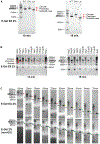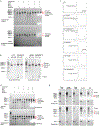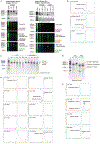Circular RNA migration in agarose gel electrophoresis
- PMID: 35358469
- PMCID: PMC9081248
- DOI: 10.1016/j.molcel.2022.03.008
Circular RNA migration in agarose gel electrophoresis
Abstract
Circular RNAs are garnering increasing interest as potential regulatory RNAs and a format for gene expression. The characterization of circular RNA using analytical techniques commonly employed in the literature, such as gel electrophoresis, can, under differing conditions, yield different results when attempting to distinguish circular RNA from linear RNA of similar molecular weights. Here, we describe circular RNA migration in different conditions, analyzed by gel electrophoresis and high-performance liquid chromatography (HPLC). We characterize key parameters that affect the migration pattern of circular RNA in gel electrophoresis systems, which include gel type, electrophoresis time, sample buffer composition, and voltage. Finally, we demonstrate the utility of orthogonal analytical tests for circular RNA that take advantage of its covalently closed structure to further distinguish circular RNA from linear RNA following in vitro synthesis.
Keywords: E-gel; RNase H; RNase R; circRNA; circular RNA; electrophoresis.
Copyright © 2022 The Authors. Published by Elsevier Inc. All rights reserved.
Conflict of interest statement
Declaration of interests H.Y.C. and R.C. are named as inventors on patents related to circRNA held by Stanford University. D.G.A. and A.W. hold equity in Orna Therapeutics, and A.W. is an employee of Orna Therapeutics. B.T.A. is an employee of Eli Lilly and Company. R.C. is a consultant for Circ Bio and an employee of Cartography Biosciences. H.Y.C. is a member of the Molecular Cell Advisory Board, co-founder of Accent Therapeutics, Boundless Bio, Circ Bio, and Cartography Biosciences, and an advisor of 10x Genomics, Arsenal Biosciences, Chroma Medicine, and Spring Discovery.
Figures




References
-
- Chen L-L (2020). The expanding regulatory mechanisms and cellular functions of circular RNAs. Nat. Rev. Mol. Cell Biol 21, 475–490. - PubMed
-
- Kristensen LS, Andersen MS, Stagsted LVW, Ebbesen KK, Hansen TB, and Kjems J (2019). The biogenesis, biology and characterization of circular RNAs. Nat. Rev. Genet 20, 675–691. - PubMed
Publication types
MeSH terms
Substances
Grants and funding
LinkOut - more resources
Full Text Sources
Other Literature Sources

